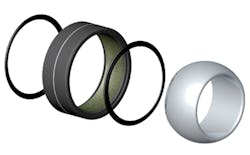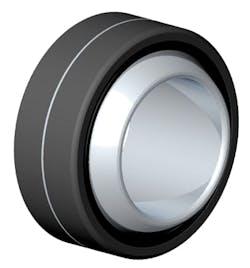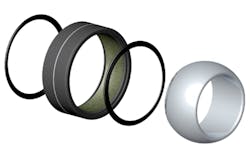Metal-to-Metal or Self-lubricating Spherical Plain Bearings: Which is Better for my Robot?
In the rapidly evolving field of robotics, the quest for components that offer high precision and flexibility is continuous. Among these components, spherical plain bearings (SPBs) stand out as pivotal elements.
This article delves into the intricacies of SPBs, clarifying their definition, functionality and the critical role they play in the realm of robotics. Learn about the key factors for choosing the right SPB for your robot, the pros and cons of different SPB types, and best practices for assembly in linkages.
Understanding Spherical Plain Bearings
Spherical plain bearings are mechanical devices designed to manage rotation and misalignment between two components. They excel in handling high radial loads while enduring minimal axial loads. An SPB comprises three main components: an outer ring, an inner ring and, in self-lubricating models, a liner that resides between the two rings. Some SPBs can also be sealed on request.
Role in Robotics
The importance of SPBs in robotics cannot be overstated. These bearings are crucial in applications demanding three-dimensional motion and the accommodation of large misalignment angles, making them a cornerstone in robotic design.
READ MORE: Linear Bearings and Actuators for Applications
It’s been said that humanoids must move organically, not robotically. Robotic movements are often stereotyped as jerky and lacking fluidity. Achieving organic, human-like movement requires bearings that offer minimal torque and clearance. SPBs have outstanding performance with both torque and clearance values nearing zero.
The inverse relationship between torque and clearance is important to understand; as torque decreases, clearance increases, and vice versa. Collaborating with a bearing manufacturer is essential to control these specifications according to design requirements. A bearing manufacturer is able to preload the bearing to reduce clearance, even having a negative clearance if needed. However, negative clearance comes at the cost of having a higher friction torque which is acceptable in certain designs.
Choosing the Right SPB for Your Robot
SPBs are available in two primary designs—metal-to-metal and self-lubricating—and can be manufactured with seals. While both options are viable depending on the robot’s load requirement, backlash and torque specifications, there are pros and cons to each.
Metal-to-metal:
Pros: Can handle alternating and high impact loads and have longer life performance.
Cons: Require maintenance and lubrication, cannot be preloaded, leading to higher initial clearance/backlash, high rotational friction under load.
Self-Lubricating:
Pros: Maintenance-free, perform well under constant loads, can be preloaded for minimal or negative clearance/backlash, low rotational friction under load and dampen noise through the fabric liner.
Cons: Higher costs, scarcity of quality self-lubricating materials in the market, and heavy impact loads may cause permanent deformation for self-lubricating liners.
Self-lubricating Materials
Numerous factors influence the material selection process, including temperature, load requirements and impact load performance. Among the various self-lubricating PTFE types, some popular designs are:
- Bronze PTFE fabric
- TSA composite
- PF fabric
- Glass fiber PTFE fabric
Bronze PTFE fabric. This design features bronze wires weaved with PTFE fiber to stiffen the liner. The liner is then placed between the inner and outer ring of the SPB. Bonding PTFE/bronze to the SPB presents a challenge due to poor adhesion. Swaging the SPB’s outer ring aids in securing the liner, and the SPB ball’s finely machined surface lowers friction, further stabilizing the liner. This material is not recommended for robotics due to bonding difficulties and due to the bronze having low tensile strength.
TSA composite. A layer of bronze powder is sintered to the steel backing and a layer of PTFE is impregnated into the porous bronze. After curing, the bearing is press-fitted into the outer ring of the SPB. This material performs exceptionally well in shock absorber SPBs. In robotics, it’s advisable to use this only when the loads are light.
READ MORE: A Gallery of Common Bearings
PF fabric. Some manufacturers have adopted woven PTFE fabric for SPBs, which is showing significant promise in the robotics sector. PF is a series of PTFE fabrics developed by CCTY. It improves bonding, wear resistance and strength by weaving different types of high-performance fibers with PTFE fiber. The back side of the fabric has a lower percentage of PTFE material to increase the bonding capabilities. Gluing and baking are also essential to help increase the stiffness of the fabric liner by filling all the porosities in the fabric.
Glass fiber PTFE fabric. This self-lubricating material incorporates glass fiber, enabling it to withstand high compressive loads. However, bonding to the outer ring of the SPB can be challenging. Usually, this material is mixed with other fibers to help improve its bonding capabilities and reduce friction.
The swaging process greatly affects the PTFE liners during assembly. It must be executed with precision to prevent fabric shredding. Low precision machinery can complicate this process, and damaged/shredded fabric compromises load-bearing capacity, resulting in early bearing failure.
The quality of the PTFE fabric is another essential factor affecting the performance of the SPB. Bearing manufacturers have formulation labs and material engineers working to innovate materials that meet the demands of the dynamic robotics market. Since not all PTFE liners are created equal, exploring different suppliers is advisable.
Assembly of SPBs in Linkages
An assembly is when a SPB is shipped to the customer inside of its housing. For example, two SPBs are set inside a dog bone linkage and sent as a single unit.
READ MORE: The Need for Speed: Ergometers can Benefit from Lube-Free Bearings
One of the main benefits of opting for an assembly is precise control of torque and clearance. When the bearing manufacturer produces both the bearing and mating part, they can hold tighter clearance specifications. Other benefits include:
Critical housing tolerance. Housing tolerance plays a crucial role in maintaining consistent internal clearance and friction torque in SPBs. Even a slight tightness in the SPB housing—measured in microns—can cause the outer ring to bind, significantly increasing torque and potentially leading to bearing lockup. If the bearing manufacturer produces the entire assembly, the bearing and the housing, they can guarantee the bearing specs hold post-assembly.
Assembly simplification. Pre-assembled SPBs alleviate assembly concerns, making installation easier and more efficient.
Weight and size reduction. Pre-assembled SPBs can potentially reduce overall weight and size in the final assembly.
Enhanced misalignment capability. Integrated SPBs can achieve higher misalignment angles, which is proving to be an important aspect for the robotics sector.
Forging facility advantage. If the manufacturer has their own forging facility, it opens up new possibilities. In-house forging allows for manufacturing of complete assemblies, including linkages and housings with integrated bearing components.
Assembly Considerations
Supplier distinction. Forged SPB housings, such as linkages, are typically produced by a separate supplier from the bearing manufacturer. This separation arises because most bearing manufacturers lack their own forging facilities. It is recommended that robotic companies find a manufacturer with in-house forging capabilities. This allows for more control over the design, faster turnaround times and all the other previously mentioned benefits.
Axial security. To prevent SPBs from travelling in the housing during operation, they should be axially secured. This can be achieved either by swaging or by using snap rings, depending on how the SPB fits within the housing.
Sourcing Recommendations
- Robotic companies should consult bearing manufacturers for the recommended assembly procedure when sourcing SPBs.
- It is essential to verify that the forging supplier adheres to the recommended tolerances given by the bearing manufacturer.
Spherical plain bearings are integral to the advancement of robotics. They offer unmatched versatility and performance in accommodating three-dimensional movements and misalignment. The selection and assembly of SPBs are critical processes that require careful consideration and expertise. By understanding the nuances of SPB types and assembly methods, robotic engineers can significantly enhance the functionality and efficiency of their designs.
SPBs have transformative potential to optimize robotic designs, ensuring both functionality and innovation.
About the Author

Yaman Obaid
Mechanical Engineer, CCTY
Yaman Obaid is a mechanical engineer specializing in robotics for CCTY, a global manufacturer of precision motion control products with offices in China, North America, Europe, Japan and India. Click here for more information.


